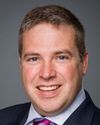I think it was. I'm not going to say that there was a large injection of funding. Certainly there was some additional funding, but what really happened was an organizational decision, a leadership decision, that we needed to standardize what these cemeteries look like.
We do have some funding, which is part of this national shrine commitment, that has been set aside to do things such as major overhauls. If you have an old cemetery, where the headstones are tilted or are very dirty, we can do a major overhaul with this special funding for things like that. But the standards really apply to the day-to-day operational upkeep of the cemetery. If the cemetery staff are doing what they're supposed to be doing, they can keep those cemeteries at national shrine standards just by doing what they're supposed to be doing on a day-by-day basis. To get them there, we had to put those standards in place.
A lot of people worked for a very long time to get that right. Put them in place and it filters all the way down to the lowest-grade worker in the cemetery. They all understand what those standards are, all the way up to the leadership, and they can articulate them. Everybody knows. There's no question about how tall the grass should be. It's throughout the organization, with everybody understanding it. It's more about education and then holding people accountable.
The other thing we've done is develop an academy for our cemetery directors. This has been in place since 2003, I believe. All of our new directors go through a one-year program at an academy in St. Louis, Missouri. They learn cemetery operations in a standardized format. In the past, there were people who were hired from here, there, and everywhere, and they would go into this isolated area, and they were on their own. That's when things started to not look the way we wanted them to look. Now we've standardized it. We have an academy. We've graduated three or four classes now. And these new directors are going out and they understand it. It has just been phenomenal. It's wonderful.





